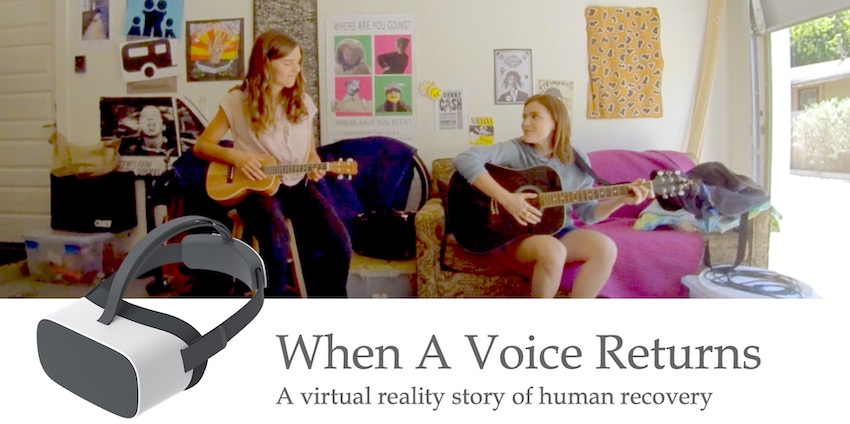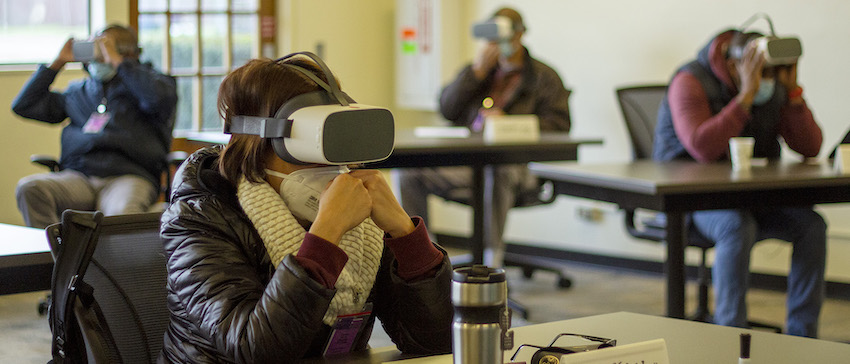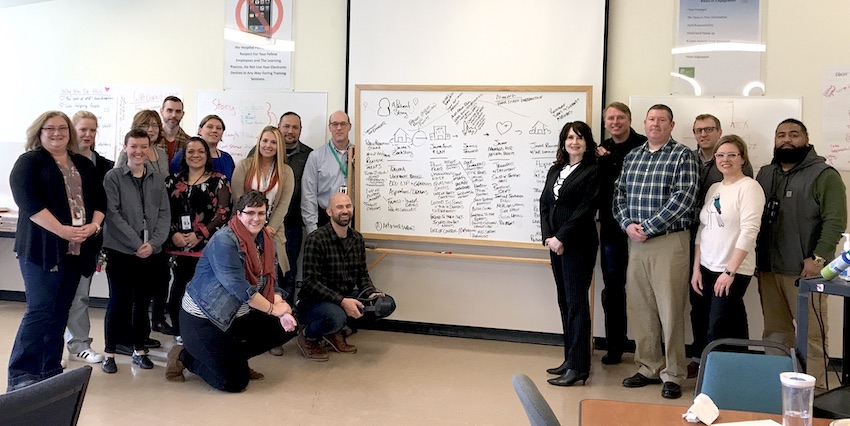
At Western State Hospital's new employee orientation, staff are equipped with high-resolution virtual reality (VR) headsets that transports them into the life of one of their patients living with schizophrenia. The Department of Social and Health Services is utilizing the latest in VR training technology to build greater empathy and enhance safety efforts at the state's oldest and largest 24/7 facility.
Building Empathy for Patient Experiences
The training introduces staff to Lena, a single mom and a musician working hard to make ends meet. As the disorienting symptoms of schizophrenia slowly alter her sense of reality, Lena makes a terrible mistake that throws her life into crisis. Staff trainees follow her through the legal system, court-ordered treatment at Western and her long journey to mental health recovery.
|
“This VR training will prepare people for the job ahead while helping staff, who are often young and inexperienced with the unpredictable situations that happen in a psychiatric facility, build empathy for those who have been diagnosed with a mental illness. This will allow them the ability to actually walk in the shoes of our patients and help them understand and look for different reactions so they are able to provide care in a safer environment for all.” - Cheryl Strange, DSHS Secretary |
|---|
In this 5-minute video, watch samples from the virtual reality training and hear from behavioral health and virtual reality experts about how the project came together.
Why apply virtual reality at a psychiatric hospital?
Research, such as a 2018 Stanford study, provides evidence that virtual reality can help make people more empathetic and has a positive impact on behavior change. We believe that every staff member in every profession, from food service to psychiatry, can create empathetic, therapeutic relationships with patients that support their recovery.
The virtual reality training, experienced in 5-episodes over two weeks of orientation, gives all incoming hospital staff a person-centered perspective of what real patients may be feeling or experiencing.
|
"I've heard people say they hear voices. But I've never seen something make it more real. I think this (VR training) will help me more when I'm talking to somebody and they're not responding. - Registered nurse at Western State Hospital |
|---|
The VR training was also designed to compliment key learning objectives taught throughout orientation, such as understanding mental illness, verbal de-escalation techniques and understanding the patient as a whole person.

Above: A new staff member watches Lena's story in a virtual reality headset during New Employee Orientation. Photo by Nathan Olson.
Real stories by real patients, real staff
Lena’s story was informed and developed by real former and current patients at Western and Eastern State Hospital who shared about their experiences with mental illness, hospital care and their recovery journey. Seasoned staff from both hospitals, such as nurses, clinicians, trainers, social workers and mental health technicians, also ensured a realistic portrayal of staff and patient experiences in the training.
Jordan Charboneau, PhD, a forensic psychologist at Western, advised the cast and crew about nuanced progression of symptoms and treatment.
|
“It’s often the case that I hear about from patients that it's very difficult differentiating what’s real and what’s not real. It is the patient’s reality, but it might not match what’s going on around them. And that can be a terribly confusing and frustrating experience.” - Jordan Charboneau, PhD, psychologist at Western |
|---|
What staff are saying
The virtual reality training launched in Western's classroom in November 2019 and instructors are gathering student evaluation on the effectiveness of the training from each cohort. Here are a few quotes from staff after they experienced Lena's story in virtual reality.
"The story was well produced. Staff members' empathy and support was powerful."
"Seeing it from the patient's perspective really helps me see the fear they are experiencing."
"Showing Lena's mental illness and its effect on her reality stuck with me. You don't really know what a person is dealing with internally."
"They did a really good job describing Lena's progression. It was very gradual, made me feel it could have been anybody."
"We got to be put in the situation. It wasn't like you're just watching a screen. You're in the moment."

Above: Staff from Western and Eastern State Hospital, Behavioral Health Administration, and the Office of the Secretary map a common patient experience. Their expertise directly informed the virtual reality training story.
The Team Behind the Project
A dynamic team of hospital staff, patients, behavioral health experts, virtual reality production crew and DSHS leaders helped bring the virtual reality patient experience to life. Project team members and advisors include:
|
Cheryl Strange |
Sean Murphy Assistant Secretary, Behavioral Health Administration |
Western State Hospital Executive Cabinet |
|---|---|---|
| Chocolate Milk & Donuts Virtual Reality Production Studio |
Sara McCaslin Creative Director, Office of Innovation, Strategy & Visual Communications |
Megan Celedonia Mental Health Transformation Project Director |
| Angie Hosking Director of Organizational Development (WSH) |
James Ortega Instructional Safety Effectiveness Administrator, WSH |
Western State Hospital Training Instructors |
| Rick McKinnon Learning & Development Administrator, DSHS |
Jordan Charboneau, PhD Psychologist (WSH) |
Nick McLain, PhD Psychologist (WSH) |
This virtual reality training project was made possible by funding for hospital safety and training improvements from the Washington State Legislature and Governor Jay Inslee. The training was produced by Chocolate Milk & Donuts, a virtual reality production studio hired through a competitive bid process.
To learn more about this project, please contact Tyler Hemstreet with the Office of Communications.
